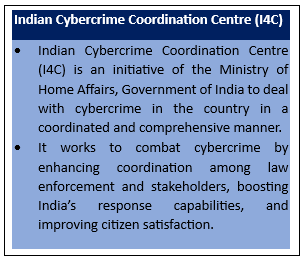Syllabus:
GS3: Role of external state and non-state actors in creating challenges to internal security.
Context:
The Ministry of Home Affairs (MHA) has estimated that a significant portion of the cyber scams targeting Indians come from Cambodia and other Southeast Asian countries.
More on the News
- The Ministry attributes over half of the approximately Rs 7,000 crore lost to online scams in the first five months of this year, January to May, to networks operating out of Myanmar, Cambodia, Vietnam, Laos, and Thailand.
- According to data compiled by the Indian Cyber Crime Coordination Centre (I4C), a unit under the MHA, these scams are often run from high-security locations reportedly controlled by Chinese operators, where trafficked people, including Indians, are forced to work.
The report cited data from the Citizen Financial Cyber Fraud Reporting and Management System (CFCFRMS), I4C’s facility for helping citizens report and manage financial cyber fraud incidents. - According to a report by Cybersecurity Ventures, cybercrime is projected to cost the global economy a staggering $10.5 trillion annually by the end of 2025, up from $3 trillion in 2015.
- An analysis of cyber frauds this year revealed that they are targeting the Indian economy, and the country faces a loss of around Rs 1,000 crore every month to such crimes.
- With the help of intelligence agencies and testimonies of rescued people, the Indian government has identified at least 45 such scam compounds in Cambodia, five in Laos, and one in Myanmar.
- A probe has revealed three types of major cybercrime frauds operating from Southeast Asia: stock trading/investment scams, digital arrest, and task-based and investment-based scams.
Reasons for High Cyber Frauds in India

- Lack of Digital Safety Knowledge: Many people, despite using smartphones and computers daily, lack basic online safety knowledge, making them vulnerable to scams like fake messages, dangerous links, and identity theft. This digital illiteracy turns them into easy targets for cybercriminals.
- Smart Criminal Methods: Today’s cybercriminals use AI to create fake videos and clone real-looking websites that steal your money; even the cautious can be deceived.
- Weak Law Enforcement: Laws exist to catch cybercriminals, but it’s tough; many operate from abroad and hide their identities, making it hard for police to track them down.
- No Borders for Online Crime: The internet connects the world, allowing criminals abroad to target people in India. Solving such cybercrimes requires global cooperation.
Initiatives to Fight Cybercrime
- Information Technology Act, 2000: This is the main law that deals with cybercrimes. It covers data theft, hacking, and identity fraud. A cybercrime lawyer can help victims understand these laws and take legal action.
- National Cyber Crime Reporting Portal: This website lets people report cybercrimes easily. It helps police respond faster and gather important information about criminals.
- Cyber Crime Coordination Centre: This organization connects different agencies to investigate cybercrimes better. It strengthens India’s overall cybersecurity.
- The Digital Personal Data Protection Act of 2023: It aims to protect the digital personal data of individuals in India by establishing a framework for its processing and usage.
It can help tackle cyber fraud by establishing clear guidelines for data handling and accountability, which in turn can reduce the risk of data breaches and misuse of personal information. - The three new criminal laws, namely, the Bharatiya Nagarik Suraksha Sanhita (BNSS), 2023, the Bharatiya Nyaya Sanhita, 2023, and the Bharatiya Sakshya Adhiniyam, 2023, respectively, also address the evolving digital landscape and the growing threat of cybercrime.
Way Forward
- Strengthen Cyber Laws: Update the IT Act and related laws to address new types of fraud and digital crimes.
- Faster Investigation & Justice: Set up dedicated cybercrime units and fast-track courts for quicker resolution.
- National Cybersecurity Policy: Implement a robust, unified policy with clear guidelines for prevention, response, and recovery.
- Public Awareness Campaigns: Educate citizens on common fraud tactics, safe online practices, and how to report incidents.

